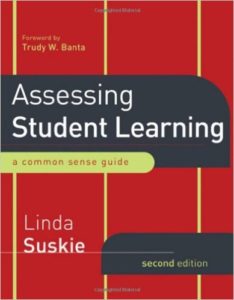 I am a big fan of bottom-up assessment and backward design (Wiggins & McTighe, 2005). When I plan class, I spend time thinking about what exactly I want my students to know. I look at my department and disciplinary learning outcomes and start there. Some of my favorite references:
I am a big fan of bottom-up assessment and backward design (Wiggins & McTighe, 2005). When I plan class, I spend time thinking about what exactly I want my students to know. I look at my department and disciplinary learning outcomes and start there. Some of my favorite references:
- Angelo, T. A., & Cross, K. P. (1993). Classroom Assessment Techniques. San Francisco, CA: Jossey-Bass.
- Berk, A. A. (2006). Thirteen strategies to measure college teaching: A consumer’s guide to rating scale construction, assessment, and decision making for faculty, administrators, and clinicians. Stylus.
- Gurung, R. A. R., & Landrum, R. E. (2012) Using SoTL to improve learning outcomes. In J. Groccia, M. Alsudairy, & W. Buskist (Eds.) Handbook of College and University Teaching: Global Perspectives. SAGE.
- Maki, P. L. (2011). Assessing for learning: Building a sustainable commitment across the institution.Stylus.
- Stevens, D. D., & Levi, A. (2011). Introduction to rubrics: An assessment tool to save grading time, convey effective feedback, and promote student learning. Stylus.
- Suskie, L. (2018). Assessing student learning: A common sense guide (3rd ed.). Jossey-Bass/Wiley.
- Walvoord, B. E. (2004). Assessment clear and simple: A practical guide for institutions, departments, and general education. San Francisco, CA: Jossey-Bass.
- Wiggins, G., & McTighe, J. (2005). Understanding by design (2e). Association for Supervision and Curriculum Development.